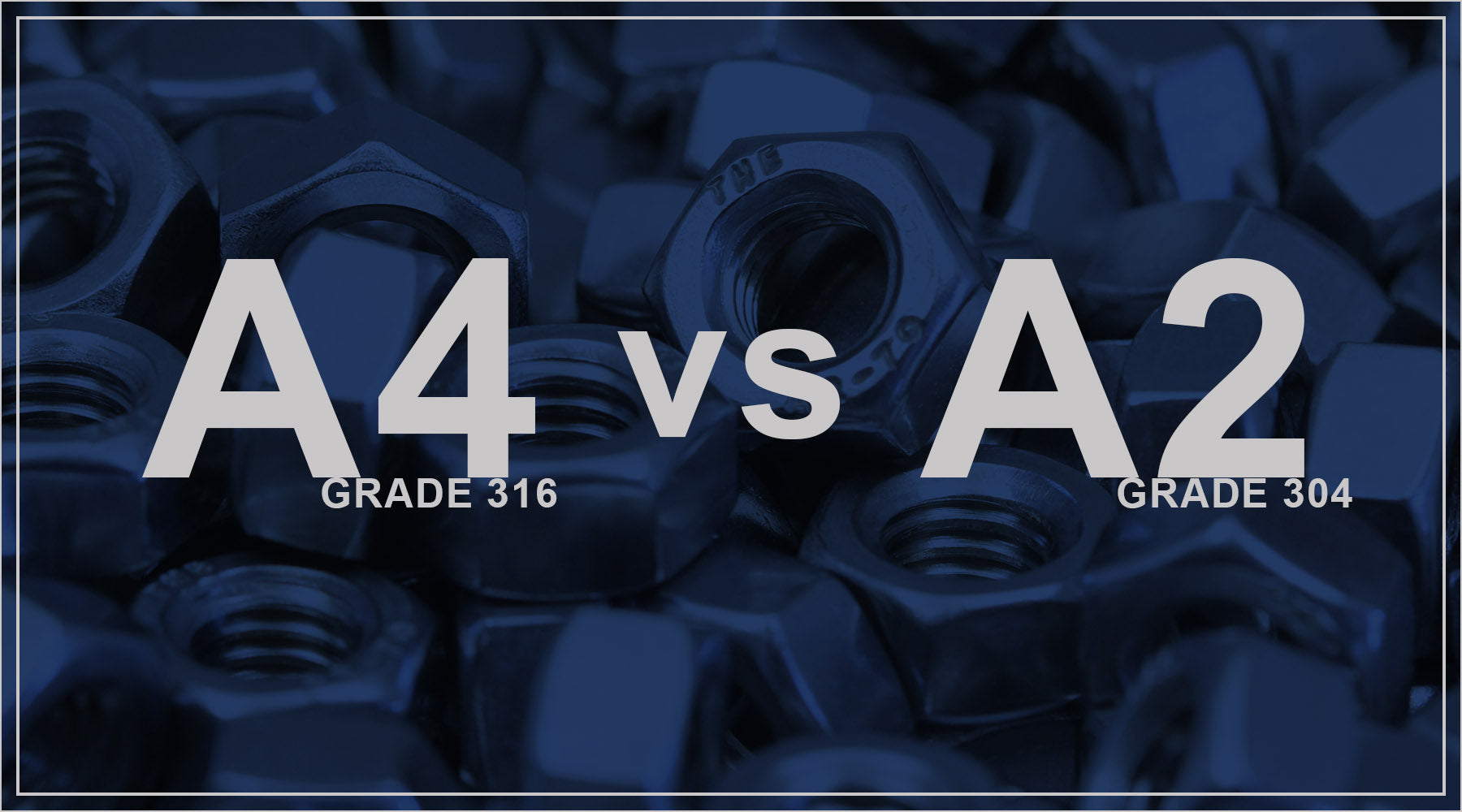A2 (304) and A4 (316) look alike—but they don’t perform the same in chloride (salt) environments. This guide explains the naming (A2=304=18-8; A4=316), the role of molybdenum (Mo) in pitting resistance, typical property classes (A2-70/A4-70), galvanic pairing do’s and don’ts, and when to step up to true “marine grade.”

A2 vs A4: Names, Equivalents & What They Mean
A2 is another name for Type 304 stainless. In U.S. inch fasteners it’s commonly called 18-8. A4 corresponds to Type 316 (often marketed as “Marine Grade”). The big difference is that 316 contains molybdenum (Mo), which significantly improves resistance to pitting and crevice corrosion in chloride environments (salt air, splash, road salts, pool chemicals).
Chemical Composition (Typical Fastener Ranges)
| Grade | Common Names | Cr (%) | Ni (%) | Mo (%) | C ≤ |
|---|---|---|---|---|---|
| A2 / 304 / 18-8 | Metric: A2 • Inch: 18-8 / 304 | 18.0–20.0 | 8.0–11.0 | — | 0.08% |
| A4 / 316 | Metric: A4 • Inch: 316 (“Marine Grade”) | 16.0–18.0 | 10.0–14.0 | 2.0–3.0 | 0.08% |
Why it matters: Mo in A4/316 increases pitting resistance in chloride environments vs. A2/304.
Strength & Property Classes (Not “A4 is stronger”)
A2 and A4 materials are offered in property classes (e.g., A2-70, A4-70, A4-80). Strength depends on the property class—not whether it’s 304 or 316.
| Marking | Typical Tensile Strength (MPa) | Notes |
|---|---|---|
| A2-70 / A4-70 | ~700 | Most common fastener class |
| A2-80 / A4-80 | ~800 | Higher strength variant |
For a broader view, see the Stainless Steel Strength Chart.
When to Choose A4 (316) Over A2 (304)
- Coastal & Marine: Salt air, splash zones, docks, boat lifts, deck hardware near shorelines.
- Chlorides/Chemicals: De-icing salts, pool equipment, bleach washdowns, some process chemicals.
- Crevice/Standing Water: Tight joints, gaskets, shaded splash areas where moisture lingers.
- Higher Budget for Corrosion Life: A4 typically costs more but lasts longer in chloride exposure.
For most indoor or non-chloride outdoor uses, A2 (304) offers excellent value and corrosion resistance.
Galvanic Pairing & Coastal Use (Quick Reference)
Mixing metals can accelerate corrosion, especially in the presence of an electrolyte (saltwater). Use similar potentials and isolate dissimilar pairs when possible.
| Fastener | Mating Material | Salt/Coastal Exposure | Recommendation |
|---|---|---|---|
| A2 (304) Stainless | Aluminum | Moderate–High | Use A4 (316) instead, add isolating washers/bushings; seal joints. |
| A4 (316) Stainless | Aluminum | High (Marine) | Preferred; still isolate dissimilar metals where feasible. |
| A4 (316) Stainless | Carbon Steel (painted) | High | OK with coatings intact; add washers/sealant; inspect coating breaks. |
| A4 (316) Stainless | Copper/Brass/Bronze | High | Generally compatible; isolate where possible to reduce crevice sites. |
Tip: Pair A4 with 316/A4 rigging hardware for best coastal performance.
Installation Notes: Get the Most from Stainless
- Prevent galling: Use proper lubrication/anti-seize and steady torque. See galling guide.
- Avoid crevices: Use flat washers to spread load and reduce moisture traps. See washer guide.
- Rinse & maintain: In coastal splash/air, periodic freshwater rinses extend service life (especially for A2).
- Match accessories: Use 316 shackles, thimbles, wire rope clips, and turnbuckles in marine builds.
A2 vs A4 – Frequently Asked Questions
Is A4 (316) always necessary near the coast?
No. For covered, low-exposure locations A2 may suffice, but in salt air/splash zones and for rigging, A4 is the safer call.
Is A4 stronger than A2?
Strength comes from the property class (e.g., A2-70 vs A4-70), not the alloy itself. A2-70 and A4-70 are similar in tensile strength.
Will stainless fasteners cause galvanic corrosion with aluminum?
Potentially, especially in saltwater. Prefer A4 with isolating washers/bushings and seal the joint. Rinse periodically.
What about “18-10” stainless—is that A4?
“18-10” is a shorthand chemistry reference (≈18% Cr, 10% Ni). True A4/316 also contains ~2–3% Mo—that is the marine advantage.
How do I reduce staining (tea staining) on stainless outdoors?
Choose A4 in coastal areas, avoid crevices, rinse with fresh water, and keep mating surfaces clean and sealed.

